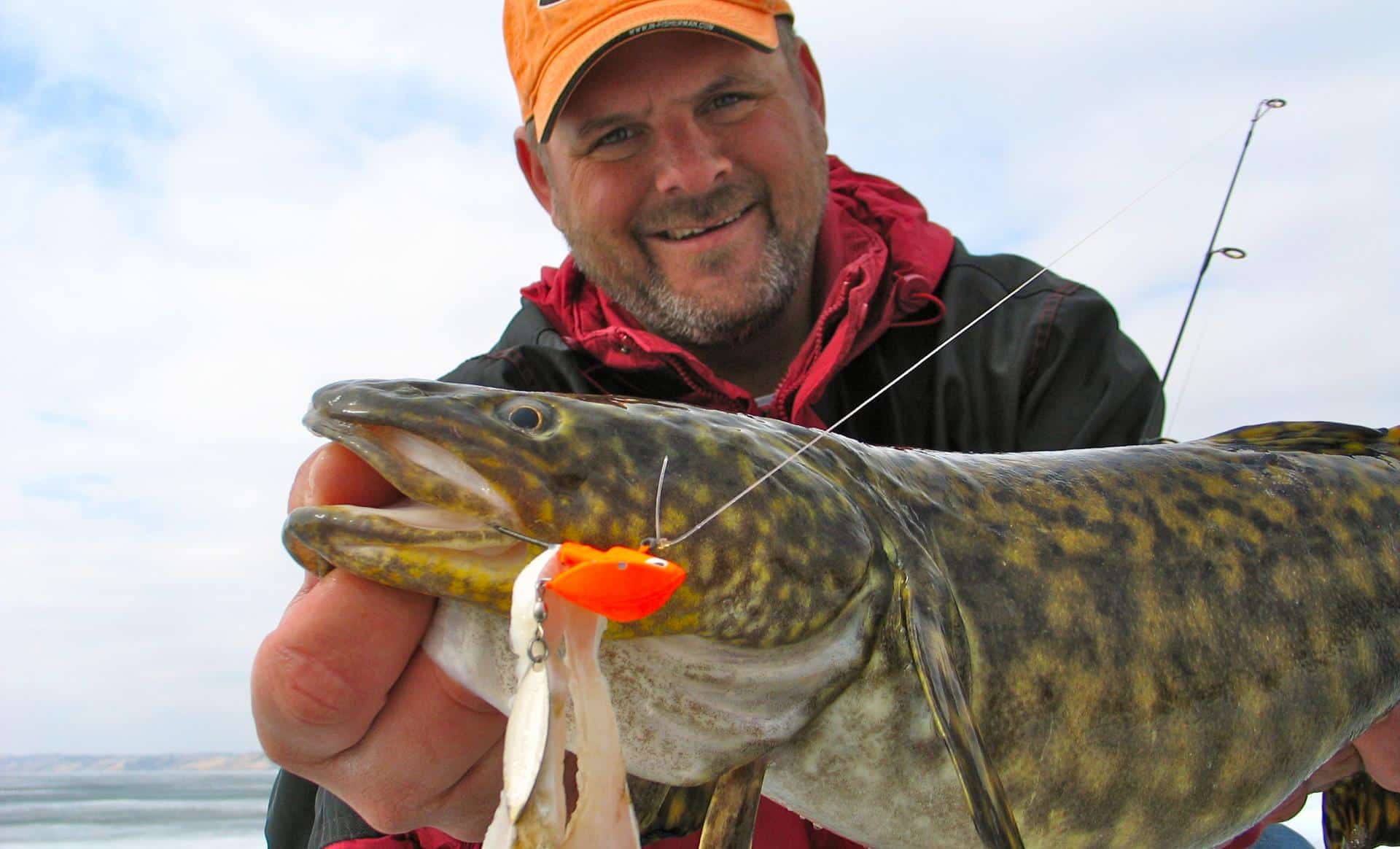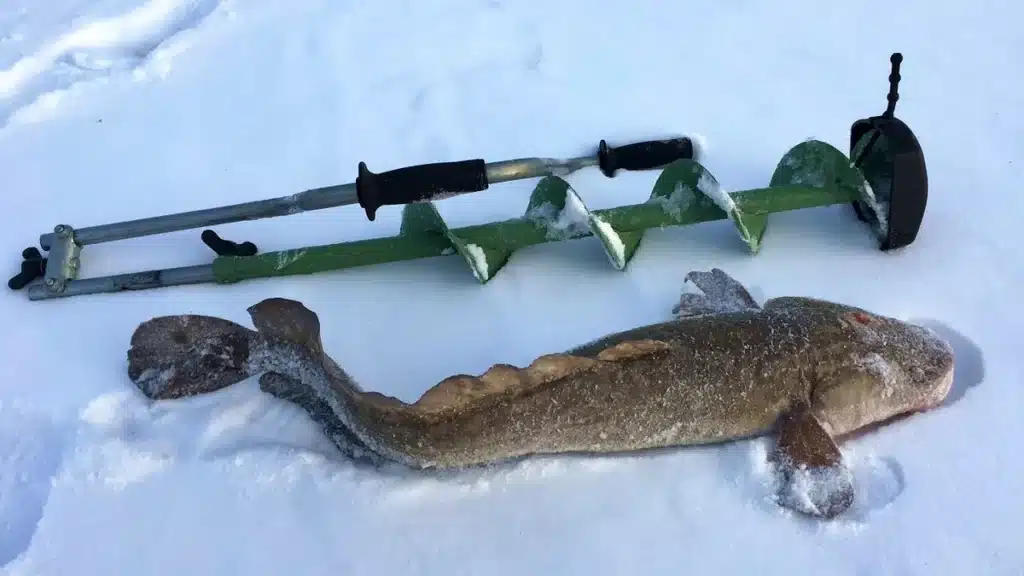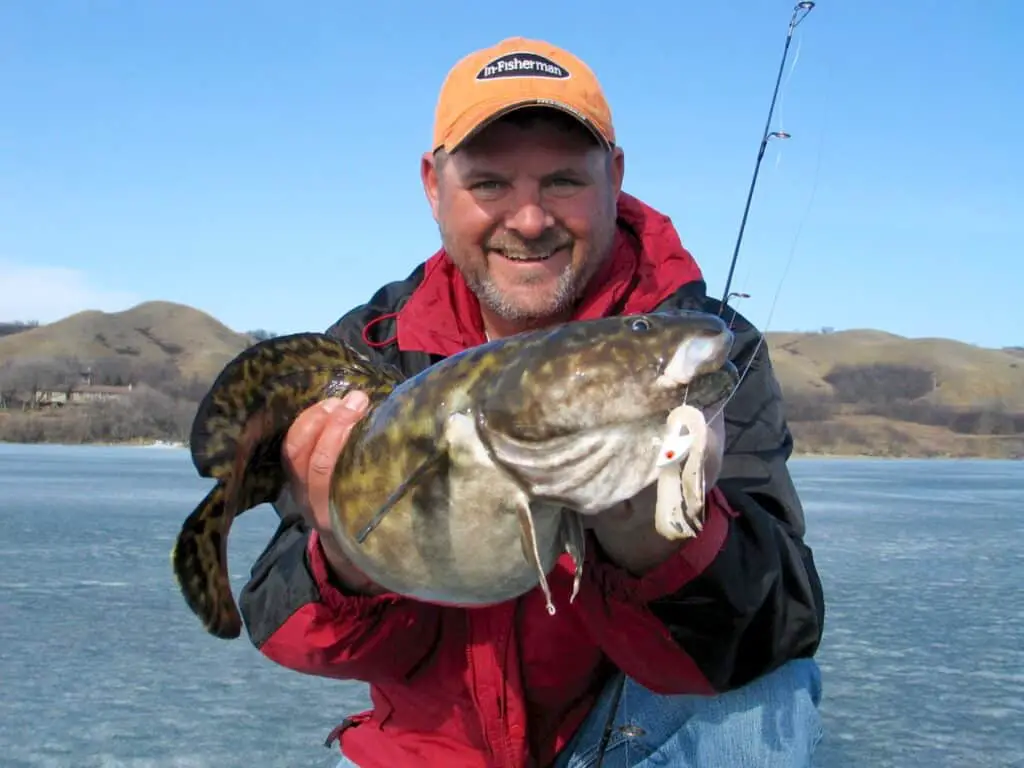How To Catch Burbot Ice Fishing

Introduction
Ice fishing for burbot, also known as eelpout or lingcod, is an exhilarating and rewarding winter pursuit for anglers seeking a unique and tasty catch. Burbot are a cold-water species that thrive in icy waters, making them a perfect target for ice fishing adventures. Whether you’re a seasoned angler looking to expand your winter fishing repertoire or a newcomer eager to try something new, learning how to catch burbot through the ice can be an exciting and fulfilling experience. In this guide, we’ll explore the techniques, gear, and strategies you’ll need to enhance your chances of hooking these elusive and delicious fish beneath the frozen surface.

What is the best time of year to target burbot through ice fishing?
The best time of year to target burbot through ice fishing is during the winter months when these cold-water fish become more active in response to dropping water temperatures. In many regions, burbot ice fishing typically starts in late fall and continues into early spring, with the peak season occurring during the coldest months of the year. Here’s why this time frame is ideal for pursuing burbot through ice fishing:
Cold Water Preferences: Burbot are well adapted to cold water and are most active when temperatures drop. During the winter, they are more likely to venture closer to the surface and become catchable through ice holes.
Spawning Season: In many areas, burbot spawn during the winter, which can trigger increased feeding activity. Anglers often target burbot during their spawning runs, which vary depending on the location but generally occur from late December to early March.
Ice Cover: The formation of a stable ice cover provides a safe and accessible platform for ice anglers to reach burbot habitat. As the ice thickens, it becomes easier to drill holes, set up equipment, and access prime fishing spots.
Reduced Light Levels: Burbot are known for their nocturnal feeding habits. The longer periods of darkness in winter provide more opportunities to catch them during daylight hours, making ice fishing a practical option.
Lack of Vegetation: In winter, aquatic vegetation typically dies back or becomes less dense, allowing anglers to fish more effectively without the hindrance of submerged plants.
Concentrated Locations: During the colder months, burbot tend to congregate in specific areas, such as deep holes, underwater structures, or areas with good prey availability. This concentration makes it easier for anglers to target them.
It’s important to note that the specific timing of the burbot ice fishing season can vary depending on your geographical location and local climate conditions. Therefore, it’s crucial to research local fishing reports, consult with experienced anglers, and be aware of any fishing regulations that may apply to your region.
What types of locations or underwater structures should you look for when ice fishing for burbot?
When ice fishing for burbot, knowing where to find these elusive fish is essential for a successful outing. Burbot tend to inhabit specific underwater structures and locations during the winter months. Here are some key types of locations and underwater structures to look for when targeting burbot through ice fishing:
Deep Holes: Burbot are known for their preference for deep water, especially during the winter. Look for areas with significant depth, such as underwater holes, channels, and basins. Depths of 20 to 60 feet or more are often productive for burbot ice fishing.
Underwater Rock Piles: Burbot are often found near rocky structures on the lake or river bottom. These structures provide cover and attract prey species, making them prime burbot hunting grounds. Drilling your ice fishing holes near underwater rock piles can increase your chances of success.
Weed Edges: While burbot are typically associated with deeper waters, they can also be found near the edges of submerged vegetation. As winter progresses and aquatic plants die back, burbot may venture into these areas to feed on smaller fish that seek refuge among the remaining vegetation.
Submerged Timber: Fallen trees and submerged logs on the lake or river bottom can be hotspots for burbot. These structures provide cover and ambush points for burbot as they wait for prey to pass by. Drilling your ice holes near submerged timber can yield productive results.
Bridge Pilings and Docks: In some areas, burbot are known to congregate near bridge pilings and docks. These man-made structures offer shade and cover, making them attractive to burbot as potential hunting grounds. Check local regulations and permissions to ensure you can fish near such structures.
Drop-Offs and Points: Burbot often moves along underwater drop-offs and points. These features can act as natural funnels for prey species, making them ideal locations for setting up your ice fishing gear.
Areas with Current: In rivers and moving water bodies, burbot may be found in areas with slow to moderate current. Look for spots where they can conserve energy while waiting for food to drift by.
Remember that burbot are nocturnal feeders, and they are more active during the nighttime hours. Therefore, it’s a good idea to plan your ice fishing trips during the late afternoon, evening, and early morning when burbot are most likely to be actively hunting.
Additionally, always check local fishing regulations, as some areas may have specific rules or closed seasons for burbot fishing. Properly understanding the underwater terrain and structures in your chosen fishing location can significantly improve your chances of a successful burbot ice fishing expedition.
What are the preferred bait options for luring burbot under the ice?
Selecting the right bait is crucial when ice fishing for burbot, as these fish can be finicky eaters. Offering the right bait can significantly increase your chances of success. Here are some preferred bait options for luring burbot under the ice:
Cut Fish: One of the most effective baits for burbot is fresh-cut fish, such as cisco, whitefish, or sucker. Cut the fish into chunks or strips, and use the freshest bait available. Burbot are attracted to the scent and taste of these fish, which mimics their natural prey.
Live Bait: Live baitfish, like small perch, shiners, or chubs, can be highly effective for burbot ice fishing. Hook them through the back or lip and allow them to swim freely in the water. The movement and scent of live bait can entice burbot to strike.
Nightcrawlers: Nightcrawlers or large earthworms are a reliable option for burbot. Thread the nightcrawler onto a hook or use a series of smaller pieces to create a scent trail in the water. Nightcrawlers can be especially effective in locations where burbot feed on invertebrates.
Frozen Baits: In areas where fresh bait is hard to come by, frozen options like herring, smelt, or shad can work well. These baits retain their scent and can be cut into pieces or used whole.
Artificial Baits: While live and fresh baits tend to be more successful, some anglers have had luck with artificial baits like soft plastic grubs, tubes, or creature baits. Choose baits in natural colors and add scent attractants to enhance their appeal.
Scent Attractants: Adding scent attractants or oils to your bait can make it more appealing to burbot. Smelly, oily concoctions like shrimp or herring oil can help draw burbot to your bait.
Glow-in-the-Dark Lures: Burbot ice fishing often takes place in low-light conditions or at night. Using glow-in-the-dark lures or bait, especially those that mimic common prey like small fish or amphipods, can increase visibility and attract burbot in the dark.
When selecting bait for burbot ice fishing, it’s essential to experiment and adjust your approach based on local conditions and the preferences of the fish in your chosen location. Additionally, consider using a variety of bait options to see what works best on a given day. Always check local fishing regulations regarding bait restrictions and size limits to ensure compliance while ice fishing for burbot.
What are some essential gear and equipment considerations for burbot ice fishing?
Successful burbot ice fishing requires specialized gear and equipment to withstand cold conditions and effectively target these fish. Here are some essential gear and equipment considerations for burbot ice fishing:
Ice Fishing Shelter: A good-quality ice fishing shelter or ice hut is crucial for staying warm and comfortable during long hours on the ice. Portable shelters with insulation and windproof features are ideal for burbot ice fishing, especially in extreme cold.
Ice Auger: You’ll need an ice auger to drill holes through the ice. Hand augers are lightweight and portable, while gas or electric-powered augers are quicker for drilling multiple holes. Ensure you have sharp blades to cut through thick ice efficiently.
Ice Fishing Rod and Reel: Choose a medium to heavy ice fishing rod and reel combo capable of handling burbot’s size and strength. A sensitive tip is important for detecting subtle bites. Some anglers prefer longer rods for hole hopping, while others opt for shorter ones for tight spaces inside shelters.
Ice Fishing Line: Use strong, low-stretch monofilament or fluorocarbon line with a test strength of at least 10-20 pounds. This line will provide the durability needed to handle burbot and the sensitivity to detect strikes.
Bait Pliers or Grippers: Burbot have sharp teeth and can be challenging to handle. Bait pliers or grippers are essential for safely removing hooks from their mouths and preventing injury to both the fish and angler.
Tip-Up Devices: Some ice anglers use tip-up devices to fish multiple holes simultaneously. These devices have a flag that signals when a fish has taken the bait, making them helpful for covering a larger area.
Fishing Sled or Cart: Transporting gear and equipment to your fishing spot is easier with a sled or cart. This is especially important if you’re carrying heavy items like shelters, heaters, and additional gear.
Heating Source: A portable heater can be a lifesaver on extremely cold days. Propane or kerosene heaters provide warmth inside your shelter, making your fishing experience more comfortable.
Ice Scoop or Skimmer: You’ll need a scoop or skimmer to remove ice shavings and keep your fishing hole clear of debris. This ensures your bait and lures are presented cleanly.
Safety Gear: Safety should be a priority. Essential safety gear includes ice picks or ice claws for self-rescue in case of an accidental fall into the water, warm clothing (layered for insulation), ice cleats for traction, and a life jacket if fishing on unstable ice.
Navigation and Communication: Always carry a GPS device or compass to ensure you can find your way back to shore, especially when fishing on large frozen lakes. A mobile phone with a fully charged battery and a backup power source can also be a lifesaver in emergencies.
By carefully selecting and maintaining your gear and equipment, you’ll be well-prepared for a successful burbot ice fishing adventure while staying safe and comfortable in the challenging winter conditions.
What techniques and setups work best for targeting burbot beneath the frozen surface?
Targeting burbot beneath the frozen surface requires specialized techniques and setups to entice these nocturnal predators. Here are some effective methods and setups for successful burbot ice fishing:
Set Lines with Dead Bait: One of the most popular methods for catching burbot is setting up tip-ups or stationary lines baited with dead fish. Cut a piece of fresh fish, such as cisco, whitefish, or sucker, into chunks or strips. Place the bait on a large hook, and then set it on the bottom of the lake or river. Adjust the depth based on your knowledge of the burbot’s location. When a burbot takes the bait, the tip-up flag will signal a strike. Quickly and gently set the hook to secure your catch.
Jigging: Jigging can be an effective technique for burbot ice fishing, especially when targeting active fish. Use a heavy ice fishing rod and reel combo to drop a jigging lure, such as a large bucktail jig or a lead-head jig tipped with bait, to the desired depth. Jig the bait up and down to create movement and vibrations that attract burbot. Experiment with different jigging motions and speeds to determine what entices them best.
Bait Scent: Burbot rely heavily on their sense of smell, so applying bait scent or attractants to your bait can be a game-changer. Coat your baited hooks with scent, such as shrimp oil, herring oil, or a commercial fish scent, to make your offering more appealing to burbot.
Glow-in-the-Dark Lures: Since burbot ice fishing often occurs in low-light conditions or at night, using glow-in-the-dark lures can improve visibility and attract burbot to your bait. These lures can mimic the bioluminescent qualities of burbot’s natural prey.
Underwater Cameras: Using underwater cameras can be a valuable tool for observing burbot behavior and fine-tuning your bait presentation. You can monitor your baited lines and make adjustments to lure placement or depth based on what you see on the camera’s screen.
Vary Depth and Location: Burbot move vertically in the water column, so it’s essential to experiment with different depths until you find where they are actively feeding. Start by fishing near the bottom and gradually work your way up. Pay attention to the depth at which you get bites or see burbot activity on your sonar.
Fish During Nighttime: Burbot are most active during the nighttime hours. If local regulations permit night fishing, consider heading out during the evening or early morning to increase your chances of success.
Patience and Stealth: Burbot can be cautious and easily spooked. Keep noise to a minimum, avoid excessive light, and be patient. Sometimes, burbot take their time before committing to a bite, so waiting quietly can be the key to success.
When ice fishing for burbot, it’s essential to remain adaptable and willing to experiment with different techniques, baits, and setups until you find what works best on a given day. Understanding the behavior and preferences of burbot in your specific fishing location is key to consistently landing these elusive fish beneath the frozen surface.
How do you locate burbot’s typical movement patterns and feeding areas during winter?
Locating burbot during winter requires a combination of experience, research, and technology. Start by studying local fishing reports, speaking with experienced anglers, and consulting with bait shops or fishing forums to gather information on where burbot have been recently caught.
When you’re on the ice, consider using a fishfinder or sonar device to identify fish in the water column and determine their depth. Burbot are known to move vertically during their feeding patterns, so pay attention to the depth at which you mark them.
Drilling multiple holes at various depths and locations can help you cover more ground and increase your chances of finding an active burbot. Keep an eye out for signs like baitfish activity or burbot marks on your sonar to pinpoint feeding areas.
Are there specific ice fishing regulations or restrictions related to burbot in your region?
Fishing regulations for burbot can vary by region and are subject to change. It’s essential to familiarize yourself with the specific regulations governing burbot fishing in your area. Check with your state or provincial wildlife agency or visit their website for the most up-to-date information on burbot fishing regulations, including size and bag limits, open seasons, and any special restrictions that may apply to your chosen fishing location.

Conclusion
Ice fishing for burbot is an adventure that combines the beauty of the winter landscape with the excitement of landing a challenging catch. While burbot may not be the most popular species among ice anglers, they offer a unique and rewarding experience that is well worth the effort. Armed with the right knowledge, equipment, and techniques, you can increase your success rate and enjoy memorable days on the ice.
As you venture out to catch burbot through the ice, remember to prioritize safety, follow local regulations, and respect the environment. Whether you’re out on a frozen lake with friends or seeking solitary solitude, the thrill of pulling a burbot through the ice and savoring its delicious meat is an experience that will keep you coming back for more winter adventures. So, gather your gear, dress warmly, and head out to the frozen waters for a chance to catch burbot and create lasting memories in the wintery world of ice fishing.



